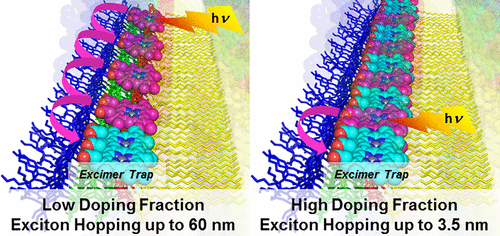Our official English website, www.x-mol.net, welcomes your
feedback! (Note: you will need to create a separate account there.)
Tailorable Exciton Transport in Doped Peptide–Amphiphile Assemblies
ACS Nano ( IF 15.8 ) Pub Date : 2017-08-29 00:00:00 , DOI: 10.1021/acsnano.7b03867 Lee A. Solomon 1 , Matthew E. Sykes 1 , Yimin A. Wu 1 , Richard D. Schaller 1, 2 , Gary P. Wiederrecht 1 , H. Christopher Fry 1
ACS Nano ( IF 15.8 ) Pub Date : 2017-08-29 00:00:00 , DOI: 10.1021/acsnano.7b03867 Lee A. Solomon 1 , Matthew E. Sykes 1 , Yimin A. Wu 1 , Richard D. Schaller 1, 2 , Gary P. Wiederrecht 1 , H. Christopher Fry 1
Affiliation

|
Light-harvesting biomaterials are an attractive target in photovoltaics, photocatalysis, and artificial photosynthesis. Through peptide self-assembly, complex nanostructures can be engineered to study the role of chromophore organization during light absorption and energy transport. To this end, we demonstrate the one-dimensional transport of excitons along naturally occurring, light-harvesting, Zn-protoporphyrin IX chromophores within self-assembled peptide–amphiphile nanofibers. The internal structure of the nanofibers induces packing of the porphyrins into linear chains. We find that this peptide assembly can enable long-range exciton diffusion, yet it also induces the formation of excimers between adjacent molecules, which serve as exciton traps. Electronic coupling between neighboring porphyrin molecules is confirmed by various spectroscopic methods. The exciton diffusion process is then probed through transient photoluminescence and absorption measurements and fit to a model for one-dimensional hopping. Because excimer formation impedes exciton hopping, increasing the interchromophore spacing allows for improved diffusivity, which we control through porphyrin doping levels. We show that diffusion lengths of over 60 nm are possible at low porphyrin doping, representing an order of magnitude improvement over the highest doping fractions.
中文翻译:

掺杂肽-两亲组装体中的可定制激子运输。
采光生物材料是光伏,光催化和人工光合作用中有吸引力的目标。通过肽的自组装,可以设计复杂的纳米结构来研究生色团在光吸收和能量传输过程中的作用。为此,我们证明了激子在自组装肽-两亲纳米纤维内沿自然发生的,采光的Zn-原卟啉IX生色团的一维运输。纳米纤维的内部结构导致卟啉堆积成线性链。我们发现这种肽组装可以使远程激子扩散,但它也诱导相邻分子之间形成激子,从而形成激子陷阱。通过各种光谱学方法证实了相邻卟啉分子之间的电子偶联。然后,通过瞬态光致发光和吸收测量来探测激子扩散过程,并将其拟合到一维跳跃模型。由于受激准分子的形成阻止了激子的跳跃,因此增加发色团间距可以改善扩散性,我们可以通过卟啉掺杂水平来控制扩散性。我们表明,在低卟啉掺杂下,超过60 nm的扩散长度是可能的,与最高掺杂分数相比,代表了一个数量级的改善。增加发色团间距可以改善扩散性,这是通过卟啉掺杂水平来控制的。我们表明,在低卟啉掺杂下,超过60 nm的扩散长度是可能的,与最高掺杂分数相比,代表了一个数量级的改善。增加发色团间距可以改善扩散性,这是通过卟啉掺杂水平来控制的。我们表明,在低卟啉掺杂下,超过60 nm的扩散长度是可能的,与最高掺杂分数相比,代表了一个数量级的改善。
更新日期:2017-08-30
中文翻译:

掺杂肽-两亲组装体中的可定制激子运输。
采光生物材料是光伏,光催化和人工光合作用中有吸引力的目标。通过肽的自组装,可以设计复杂的纳米结构来研究生色团在光吸收和能量传输过程中的作用。为此,我们证明了激子在自组装肽-两亲纳米纤维内沿自然发生的,采光的Zn-原卟啉IX生色团的一维运输。纳米纤维的内部结构导致卟啉堆积成线性链。我们发现这种肽组装可以使远程激子扩散,但它也诱导相邻分子之间形成激子,从而形成激子陷阱。通过各种光谱学方法证实了相邻卟啉分子之间的电子偶联。然后,通过瞬态光致发光和吸收测量来探测激子扩散过程,并将其拟合到一维跳跃模型。由于受激准分子的形成阻止了激子的跳跃,因此增加发色团间距可以改善扩散性,我们可以通过卟啉掺杂水平来控制扩散性。我们表明,在低卟啉掺杂下,超过60 nm的扩散长度是可能的,与最高掺杂分数相比,代表了一个数量级的改善。增加发色团间距可以改善扩散性,这是通过卟啉掺杂水平来控制的。我们表明,在低卟啉掺杂下,超过60 nm的扩散长度是可能的,与最高掺杂分数相比,代表了一个数量级的改善。增加发色团间距可以改善扩散性,这是通过卟啉掺杂水平来控制的。我们表明,在低卟啉掺杂下,超过60 nm的扩散长度是可能的,与最高掺杂分数相比,代表了一个数量级的改善。





















































 京公网安备 11010802027423号
京公网安备 11010802027423号